Woven into the fabric of faith, biblical garments tell tales of power and deceit, inviting us to uncover their deeper meanings and mysteries.
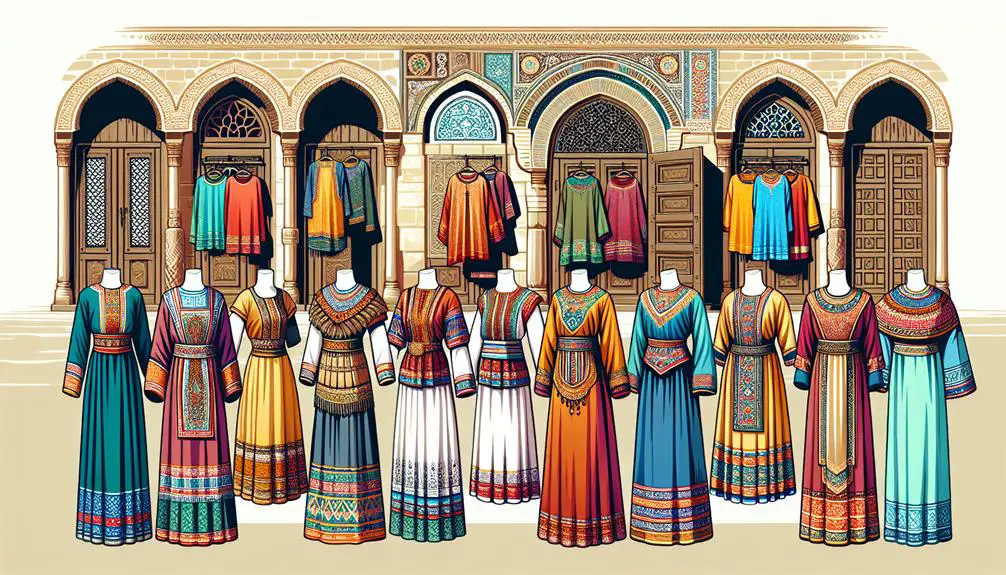
Garments in the Bible
As you weave through the tapestry of narratives in the Bible, you'll find that garments are not merely threads and colors but symbols of power, deceit, and divine authority.
From Joseph's vibrant coat that sparked envy and led to his downfall, to the seamless robe of Jesus that soldiers gambled over, these garments carry stories and lessons that resonate deeply with the human experience.
As you explore these stories, you'll uncover how fabric and thread are intertwined with faith, betrayal, and redemption.
Let's unravel these layers together and discover what lies beneath the surface of these biblical garments.
Key Takeaways
- Biblical garments symbolize societal roles, divine favor, and theological themes, such as redemption and unity.
- The design and creation of garments, like the seamless robe of Jesus, highlight skill and carry deep spiritual significance.
- Garments in the Bible can reflect fulfillment of prophecy, showing divine intervention and the unfolding of God's plan.
- Through garments, the Bible explores complex themes like authority, deception, gender dynamics, and the indivisibility of Jesus' teachings.
Joseph's Coat of Many Colors

One of the most emblematic garments mentioned in the Bible is Joseph's coat of many colors, a symbol of favoritism and the catalyst for his brothers' jealousy. This garment's narrative isn't just a tale of envy and betrayal; it's steeped in symbolic interpretations and cultural significance that merit a closer examination. You'll find that the coat's vibrant hues aren't merely for aesthetic appeal but carry deep symbolic weight.
In the ancient Near Eastern context, a multi-colored coat was an extraordinary gift, signifying distinction and authority. This wasn't an everyday garment but a token of high status, possibly denoting a prince or someone of significant rank. The act of Jacob gifting this coat to Joseph clearly marked him as the favored son, setting the stage for the ensuing familial discord. This favoritism, underscored by the coat, speaks volumes about the cultural practices and values of the time.
Moreover, the symbolic interpretations of Joseph's coat extend beyond familial favoritism. They delve into themes of destiny and divine providence. The coat, in its uniqueness, prefigures Joseph's exceptional journey from a slave to a ruler in Egypt. It's as if the coat's many colors foreshadow the multifaceted life Joseph was to lead, filled with trials, tribulations, and eventual triumph.
In essence, Joseph's coat of many colors isn't just a garment but a narrative device laden with cultural and symbolic significance. It's a testament to the rich tapestry of biblical storytelling, where even a piece of clothing can embody layers of meaning, reflecting societal norms, individual destiny, and the intricate workings of divine will.
The High Priest's Sacred Vestments

Among the myriad artifacts of religious significance in the Bible, the High Priest's sacred vestments stand out as a profound embodiment of divine commandment and spiritual symbolism. These garments, meticulously described in Exodus, aren't merely attire but are laden with symbolic meanings, each element representing a facet of the High Priest's role and the ideals of the faith. Through an analytical lens, let's delve into these vestments and their artistic representations, which have been a source of fascination and inspiration throughout history.
- The Breastplate of Judgment: This ornate piece, featuring twelve precious stones, symbolizes the twelve tribes of Israel. Each stone, inscribed with a tribe's name, signifies the High Priest's role as the intermediary between the people and God, bearing their names before the Almighty during sacred rituals.
- The Ephod: An apron-like garment, intricately woven and adorned, the ephod represents the High Priest's service and dedication. Its artistic depictions often highlight its detailed craftsmanship, underscoring the devotion and skill required in its creation.
- The Robe of the Ephod: This blue garment, with pomegranates and bells attached to its hem, serves dual symbolic purposes. The sounds from the bells announce the High Priest's movements within the Sanctuary, a reminder of his constant presence before God, while the pomegranates symbolize fruitfulness and the law.
- The Turban and the Golden Plate: The turban, topped with a golden plate inscribed 'Holy to the LORD,' signifies sanctity and dedication. This piece, prominently featured in artistic representations, visually communicates the High Priest's sacred duty and his purity before God.
Through these vestments, one appreciates the deep interconnection between divine commandment, artistic representation, and symbolic meaning, reflecting the rich tapestry of biblical narratives and religious practice.
Tamar's Garments of Deception
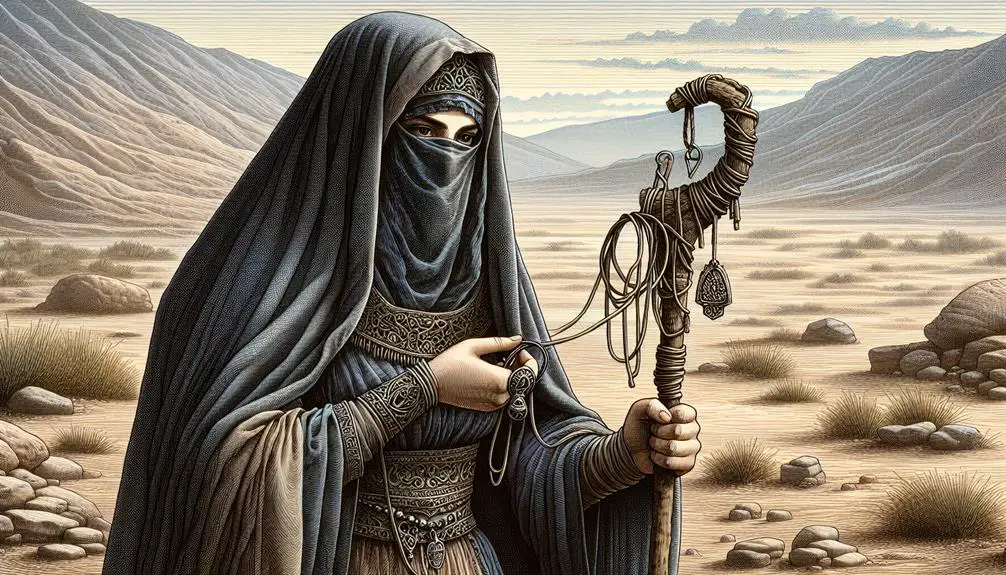
Shifting focus to Tamar's narrative, we uncover how her strategic adoption of garments serves as a pivotal act of deception, skillfully navigating societal norms to assert her place within the biblical lineage. Tamar, a widow wronged by her in-laws, orchestrates a daring plan, leveraging ancient textiles to subvert prevailing gender dynamics. She discards her widow's garments, symbols of her marginalized status, and dons a veil, assuming the guise of a prostitute. This act of transformation isn't merely about disguise; it's a profound commentary on the fluidity and power of identity as mediated through clothing.
Her choice of attire, a calculated deception, challenges the rigid structures of her time. Through this sartorial metamorphosis, Tamar negotiates her autonomy, cleverly manipulating perceptions to claim her right to offspring. It's a testament to the significance of garments as tools of negotiation and assertion within ancient societies. The textiles involved in her deception—the widow's garments she sheds and the veil she adopts—serve as critical elements in her quest for justice and recognition.
This episode compellingly illustrates the intersection of gender dynamics and ancient textiles, showcasing how garments can transcend their primary function as mere attire, becoming instrumental in the navigation of societal hierarchies. Tamar's story, rich in its complexity, offers a nuanced exploration of the roles that clothing can play in the assertion of identity and the pursuit of justice within the constraints of ancient patriarchal systems.
Elijah's Mantle of Authority
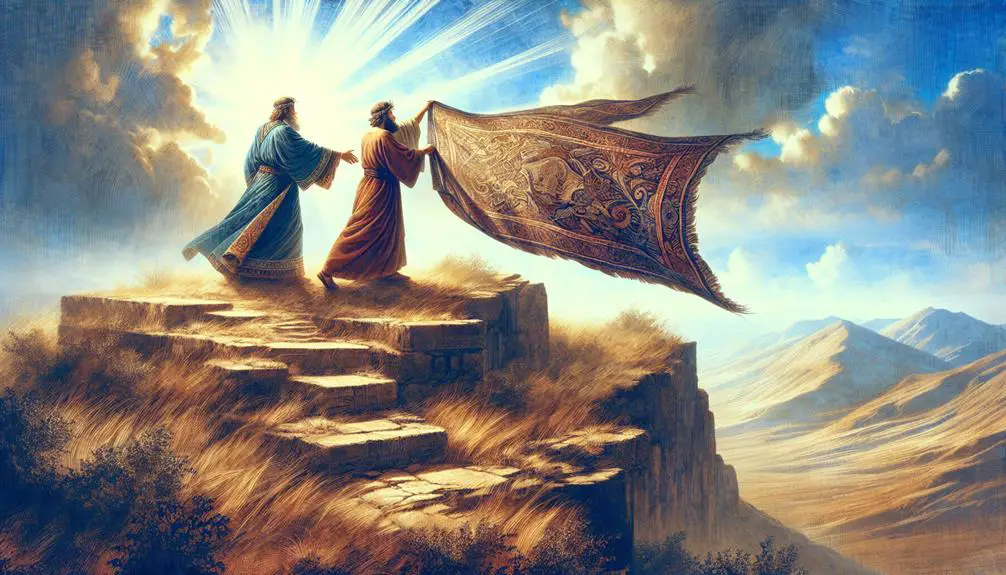
In the biblical narrative, Elijah's mantle emerges as a powerful symbol of authority and prophetic succession, underscoring the profound significance garments can hold within theological and social contexts. This garment not only signifies Elijah's role as a prophet but also marks a symbolic transition of prophetic authority to Elisha. Let's delve into how Elijah's mantle represents both a physical and metaphoric passing of the torch in the realm of prophetic inheritance.
- Symbol of Authority: Elijah's mantle is more than a garment; it's a tangible representation of his divine commission. Wearing it signifies Elijah's role as a chosen prophet of God, vested with authority to speak and act on divine directives.
- Instrument of Miracles: Throughout Elijah's ministry, the mantle serves as a tool through which God's power is manifested. It's not merely fabric; it's imbued with divine potency, illustrating the close relationship between the prophet and the divine.
- Symbolic Transition: The act of Elijah casting his mantle upon Elisha is deeply symbolic, denoting the transfer of prophetic mantle from one generation to the next. This act signifies Elisha's selection as Elijah's successor, embodying the continuity of God's prophetic mission.
- Prophetic Inheritance: For Elisha, receiving the mantle represents not just the taking up of Elijah's physical cloak but inheriting the spiritual mantle of prophetic authority. It marks the beginning of Elisha's ministry, signifying that he now carries the responsibility and power that once were Elijah's.
This narrative illustrates the rich, layered meanings garments can carry, particularly in the context of biblical symbolism and tradition.
The Seamless Robe of Jesus
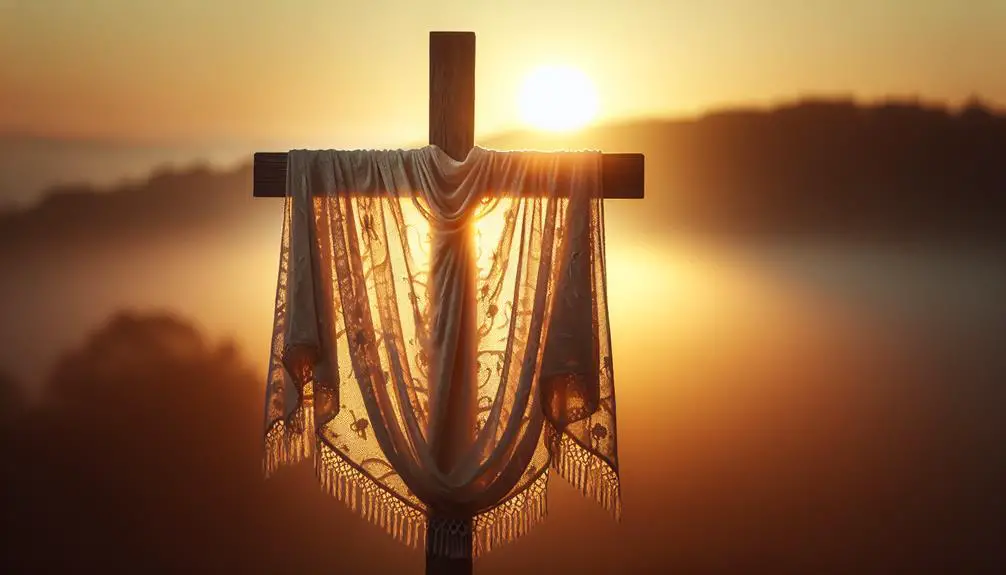
Exploring further, we now turn our attention to the Seamless Robe of Jesus, another garment of profound biblical and theological significance. This garment, unlike any other mentioned in the scriptures, carries a weight of symbolism that transcends its physical attributes. The seamless robe, often overlooked, represents unity and wholeness in the Christian faith, serving as a metaphor for the undivided Church.
Delving into the fabric techniques involved in creating such a garment, it's clear that the seamless design wasn't a product of happenstance. In ancient times, creating a garment without seams was a meticulous process, requiring advanced skill and dedication. This technique symbolized not only the care and thoughtfulness invested in the garment but also pointed to the high regard in which the wearer was held. The seamless nature of Jesus' robe, therefore, underscores his divine kingship and the perfection of his teachings.
Moreover, the decision by the soldiers to cast lots for Jesus' robe rather than dividing it further amplifies its significance. This act preserved the garment's integrity, unwittingly fulfilling prophecy and highlighting the robe's emblematic unity. It serves as a poignant reminder of the indivisibility of Jesus' message of love and redemption.
Frequently Asked Questions
How Did the Materials and Dyes for Biblical Garments Correlate With Social Status or Religious Significance?
When exploring how materials and dyes reflect social or religious standing, you'll find color symbolism and fabric sourcing crucial. Rich, vibrant dyes, often harder to obtain, signaled wealth and power. Similarly, luxurious fabrics like silk or fine linen were reserved for the elite or for sacred purposes.
This distinction in materials and colors not only marked social hierarchy but also carried deep religious significance, highlighting one's closeness to the divine or societal role.
Were There Specific Garments or Clothing Practices Used to Signify Mourning or Grief in Biblical Times?
Ironically, you're asking about ancient fashion trends for the worst parties – funerals. In those times, people used specific clothing practices as public expressions of grief. It wasn't just about looking somber; it was loaded with ritual symbolism.
Tearing one's clothes, donning sackcloth, and sprinkling ashes were the go-to styles for mourning. These practices weren't just about personal sorrow; they communicated loss and penitence to the entire community, embodying a deeply analytical and scholarly tradition.
How Did the Concept of Modesty Influence the Design and Wearing of Garments in Biblical Narratives?
In analyzing modesty's impact on clothing, it's crucial to grasp how it intertwined with gender roles and cultural norms.
You'll find that modesty wasn't just about coverage but a reflection of societal values and expectations.
Gender roles heavily dictated attire, influencing designs to align with perceived modesty standards.
These norms were deeply rooted in the culture, shaping not only personal identity but also how communities perceived and interacted with each other.
Can We Find Any Evidence of Clothing Recycling or Repurposing Among Ancient Biblical Communities?
When you explore ancient communities' approach to clothing sustainability, you'll find evidence of fabric origins being deeply intertwined with upcycling techniques.
Interestingly, 90% of textiles could be recycled, yet only 15% were. This reflects a missed opportunity in fabric resourcefulness.
Ancient practices involved repurposing garments for varied uses, showcasing an early form of recycling. These techniques highlight a thoughtful engagement with materials, emphasizing sustainability long before it became a global concern.
How Did Climate and Geography Influence the Choice of Fabrics and Styles of Garments Mentioned in the Bible?
When you consider how climate and geography shape fashion, you'll notice that trade routes and agricultural cycles significantly influenced fabric and style choices. Hot, arid climates demanded lightweight, breathable materials, while trade routes introduced diverse fabrics and designs.
The timing of agricultural cycles also dictated when certain materials were available, impacting garment production. This intersection of environment, commerce, and agriculture deeply influenced clothing trends, reflecting a practical response to regional conditions.
Conclusion
In conclusion, the tapestry of biblical narratives is richly interwoven with the threads of symbolic attire. From Joseph's vibrant tunic to the seamless garment worn by Jesus, these garments aren't mere fabric. They're potent symbols of authority, deception, and sanctity.
Your journey through these stories isn't just a sartorial exploration. It's a deep dive into the fabric of faith itself, where each thread reveals profound insights about human nature, divine intention, and the complex weave of destiny.


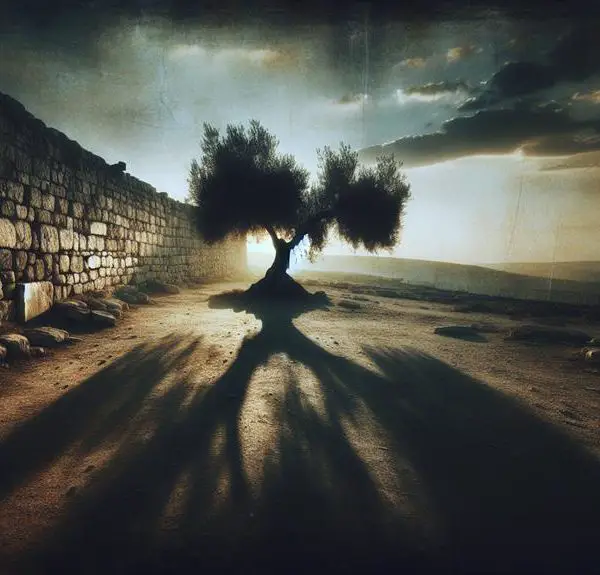
Sign up